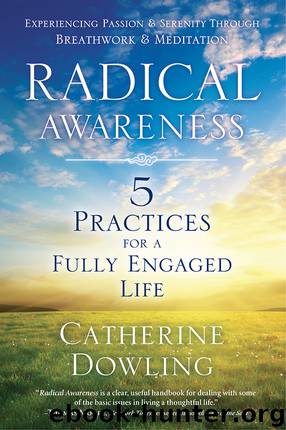Radical Awareness by Catherine Dowling

Author:Catherine Dowling
Language: eng
Format: epub
Tags: empowerment, inspiration, meditation, breathwork, breath work
Publisher: Llewellyn Worldwide, LTD.
Published: 2014-10-19T16:00:00+00:00
exercise 23: thought-stopping
a) If you’re feeling anxious, write down your thoughts. Let them flow uncensored onto the page. Then read them aloud. Do they sound even a little bit over the top, out of proportion to the situation? Can you laugh at some of them? Can you share them with a friend who can joke about them with you? Humor can put catastrophic thoughts in their place.
b) Use the meditation to silence the chatter (exercise 4) from chapter 4. If you’d like, place a candle before you and keep your eyes open. Whether your eyes are open or closed, focus your attention on your breathing without changing its volume or pace. Follow your inhale and exhale until your mind calms. When thoughts come, visualize them floating away on a river or evaporating in the heat of the candle flame. More thoughts will come; just let them float away.
c) Use the anchoring meditation (exercise 5) from chapter 4 or the alternate nostril breathing or the three-phase breathing exercise (exercise 13 and exercise 15) from chapter 6 to calm your mind. If you are chronically anxious, you will need to use these exercises every day, sometimes several times a day. Make them a priority in your life; otherwise you can slip back into anxiety.
Normal Fear
Between gut-wrenching panic and chronic anxiety lies the fear most people experience at some point in their lives, the kind of fear we regard as normal. “Normal” fear is triggered by an event as opposed to a perceived threat. Common fear-inducing events include interviews, exams, traveling alone to a new place or country, a first date, and public speaking. Because these fears are considered normal, people plow through and do what has to be done. In some cases—during an exam, for example—low-level fear can sharpen performance. But if the fear is strong enough, it can cause us to blank out during the exam. Fear can also stop us from making a speech, taking a trip, or going on that first date.
Low-level “normal” fear forms the shady background to many people’s lives: fear of rejection, fear of abandonment, fear of success or failure, fear of being alone, fear of intimacy, fear of attention or its opposite, oblivion. This type of fear is not always easy for other people to see. Shyness is apparent in children, but in adults it’s often so well disguised as either chattiness or haughtiness that it’s unrecognizable. Other fears become apparent only when you examine the span of a life. A lifetime of unfulfilled potential can point to fear of success or of failure. A lifetime of short-term relationships isn’t always due to the bad luck of never meeting the right person. Sometimes it’s the result of a subtle yet crippling fear of deep, long-term connection.
The Fear Response
The Enneagram, 34 an ancient and astonishingly accurate tool of self-awareness, describes people’s reaction to fear as either phobic or counterphobic. Nobody is phobic or counterphobic all the time, but we lean toward one or the other response. A phobic method of coping with fear looks like the timidity we usually associate with the emotion.
Download
This site does not store any files on its server. We only index and link to content provided by other sites. Please contact the content providers to delete copyright contents if any and email us, we'll remove relevant links or contents immediately.
Becoming Supernatural by Dr. Joe Dispenza(8155)
Crystal Healing for Women by Mariah K. Lyons(7889)
The Witchcraft of Salem Village by Shirley Jackson(7228)
Inner Engineering: A Yogi's Guide to Joy by Sadhguru(6751)
The Four Agreements by Don Miguel Ruiz(6693)
The Power of Now: A Guide to Spiritual Enlightenment by Eckhart Tolle(5673)
Secrets of Antigravity Propulsion: Tesla, UFOs, and Classified Aerospace Technology by Ph.D. Paul A. Laviolette(5330)
The Wisdom of Sundays by Oprah Winfrey(5118)
Room 212 by Kate Stewart(5065)
Pale Blue Dot by Carl Sagan(4945)
Fear by Osho(4693)
The David Icke Guide to the Global Conspiracy (and how to end it) by David Icke(4652)
Animal Frequency by Melissa Alvarez(4423)
Rising Strong by Brene Brown(4407)
How to Change Your Mind by Michael Pollan(4311)
Sigil Witchery by Laura Tempest Zakroff(4206)
Real Magic by Dean Radin PhD(4099)
Man and His Symbols by Carl Gustav Jung(4091)
The Art of Happiness by The Dalai Lama(4088)
